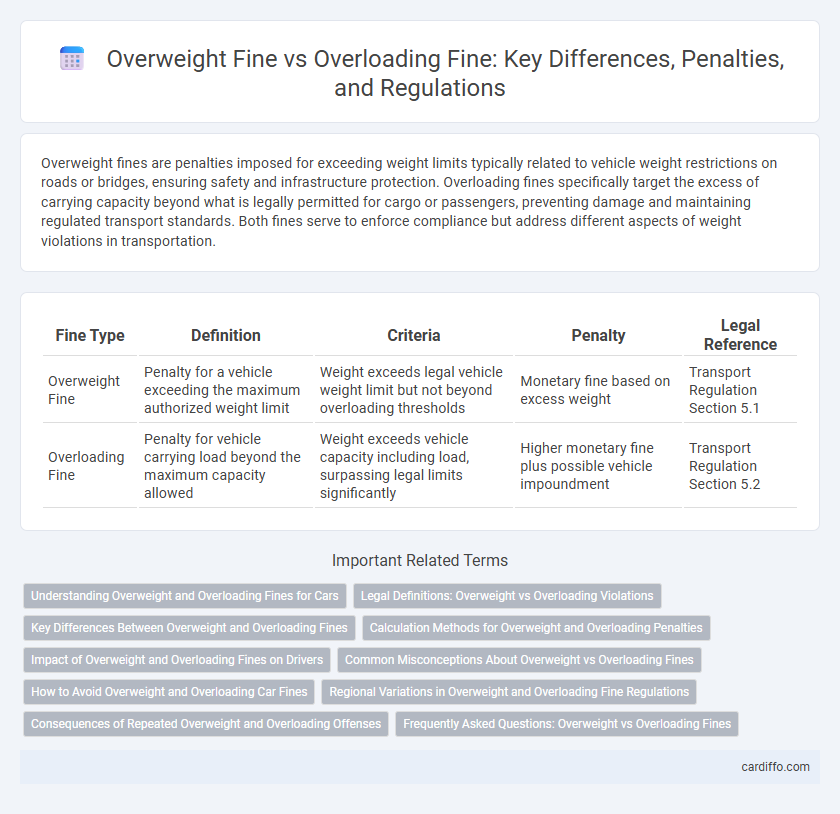Overweight fines are penalties imposed for exceeding weight limits typically related to vehicle weight restrictions on roads or bridges, ensuring safety and infrastructure protection. Overloading fines specifically target the excess of carrying capacity beyond what is legally permitted for cargo or passengers, preventing damage and maintaining regulated transport standards. Both fines serve to enforce compliance but address different aspects of weight violations in transportation.
Table of Comparison
| Fine Type | Definition | Criteria | Penalty | Legal Reference |
|---|---|---|---|---|
| Overweight Fine | Penalty for a vehicle exceeding the maximum authorized weight limit | Weight exceeds legal vehicle weight limit but not beyond overloading thresholds | Monetary fine based on excess weight | Transport Regulation Section 5.1 |
| Overloading Fine | Penalty for vehicle carrying load beyond the maximum capacity allowed | Weight exceeds vehicle capacity including load, surpassing legal limits significantly | Higher monetary fine plus possible vehicle impoundment | Transport Regulation Section 5.2 |
Understanding Overweight and Overloading Fines for Cars
Overweight fines are penalties imposed when a vehicle exceeds the legally permitted weight limit for its category, ensuring road safety and infrastructure protection. Overloading fines specifically address the illegal transport of cargo or passengers beyond the vehicle's maximum capacity, which can compromise vehicle control and increase accident risk. Understanding these fines helps drivers comply with regulations, avoid hefty penalties, and maintain road safety standards.
Legal Definitions: Overweight vs Overloading Violations
Overweight fines are penalties imposed when a vehicle exceeds the maximum weight limits established by transportation laws, focusing on the actual weight carried beyond legal thresholds. Overloading fines specifically address violations where the cargo surpasses the vehicle's designed load capacity, potentially compromising safety and vehicle integrity. Both fines enforce regulations designed to prevent road damage and ensure traffic safety, with overweight violations relating to gross weight limits and overloading concerning load distribution and vehicle specifications.
Key Differences Between Overweight and Overloading Fines
Overweight fines are imposed when a vehicle exceeds the maximum allowable weight limit specified for its type, aiming to protect road infrastructure and ensure safety. Overloading fines, on the other hand, specifically target vehicles carrying cargo beyond their designated load capacity, which can lead to mechanical failure or unsafe driving conditions. The key difference lies in overweight fines focusing on total vehicle weight, while overloading fines emphasize exceeding cargo limits.
Calculation Methods for Overweight and Overloading Penalties
Overweight fines are calculated based on the excess weight measured over the legal limit, typically using a fixed rate per ton or kilogram exceeded, as defined by regional traffic regulations. Overloading fines consider not only total weight but also axle load limits, with penalties increasing progressively depending on how much the load exceeds specific axle weight thresholds. Accurate calculation methods rely on certified weighbridge data and reference maximum allowable weights to ensure precise enforcement and compliance with safety standards.
Impact of Overweight and Overloading Fines on Drivers
Overweight fines and overloading fines significantly impact drivers by increasing financial burdens and affecting driving behavior. Overweight fines target excess vehicle weight beyond legal limits, leading to higher penalties and potential vehicle damage, while overloading fines address carrying more passengers or cargo than allowed, elevating safety risks. Both fines incentivize compliance with weight regulations, reducing road damage and promoting safer travel conditions for all road users.
Common Misconceptions About Overweight vs Overloading Fines
Overweight fines are penalties imposed when a vehicle exceeds the legal weight limit specified for its category, while overloading fines specifically address the excess weight carried beyond the vehicle's capacity or cargo limits. Many drivers mistakenly believe both terms are interchangeable, though overweight refers to the vehicle's total weight including cargo, and overloading often targets improperly distributed or unsafe load practices. Common misconceptions lead to confusion during enforcement, emphasizing the importance of understanding distinct regulations to avoid costly fines and ensure road safety compliance.
How to Avoid Overweight and Overloading Car Fines
To avoid overweight and overloading car fines, regularly check your vehicle's load against the manufacturer's weight limits and legal road regulations. Use weighing stations or portable scales to verify cargo weight before travel, ensuring compliance with local laws. Properly distributing cargo and securing excess items can prevent accidental overloading and reduce the risk of costly fines and vehicle damage.
Regional Variations in Overweight and Overloading Fine Regulations
Regional regulations on overweight and overloading fines vary significantly, with some areas imposing strict penalties based on exact weight limits and vehicle type classifications. In many jurisdictions, fines escalate with the degree of overload, reflecting the increased risk to infrastructure and public safety. Enforcement practices and fine structures are influenced by local transportation policies and economic considerations, leading to diverse penalty frameworks across regions.
Consequences of Repeated Overweight and Overloading Offenses
Repeated overweight and overloading offenses significantly increase fines and may lead to severe legal consequences, including vehicle impoundment and suspension of commercial licenses. Persistent violations damage road infrastructure, raising repair costs and risking public safety due to tire blowouts or brake failures. Enforcement agencies often escalate penalties to deter repeat offenders, emphasizing the importance of compliance in maintaining transport safety standards.
Frequently Asked Questions: Overweight vs Overloading Fines
Overweight fines are penalties imposed when a vehicle exceeds the legally allowed weight limit, risking road damage and safety hazards. Overloading fines specifically address the excess weight carried beyond the vehicle's maximum load capacity, often resulting in higher penalties due to increased risks. Both types of fines vary by jurisdiction but typically include monetary charges, points on licenses, and possible vehicle impoundment to enforce compliance.
Overweight fine vs overloading fine Infographic

 cardiffo.com
cardiffo.com